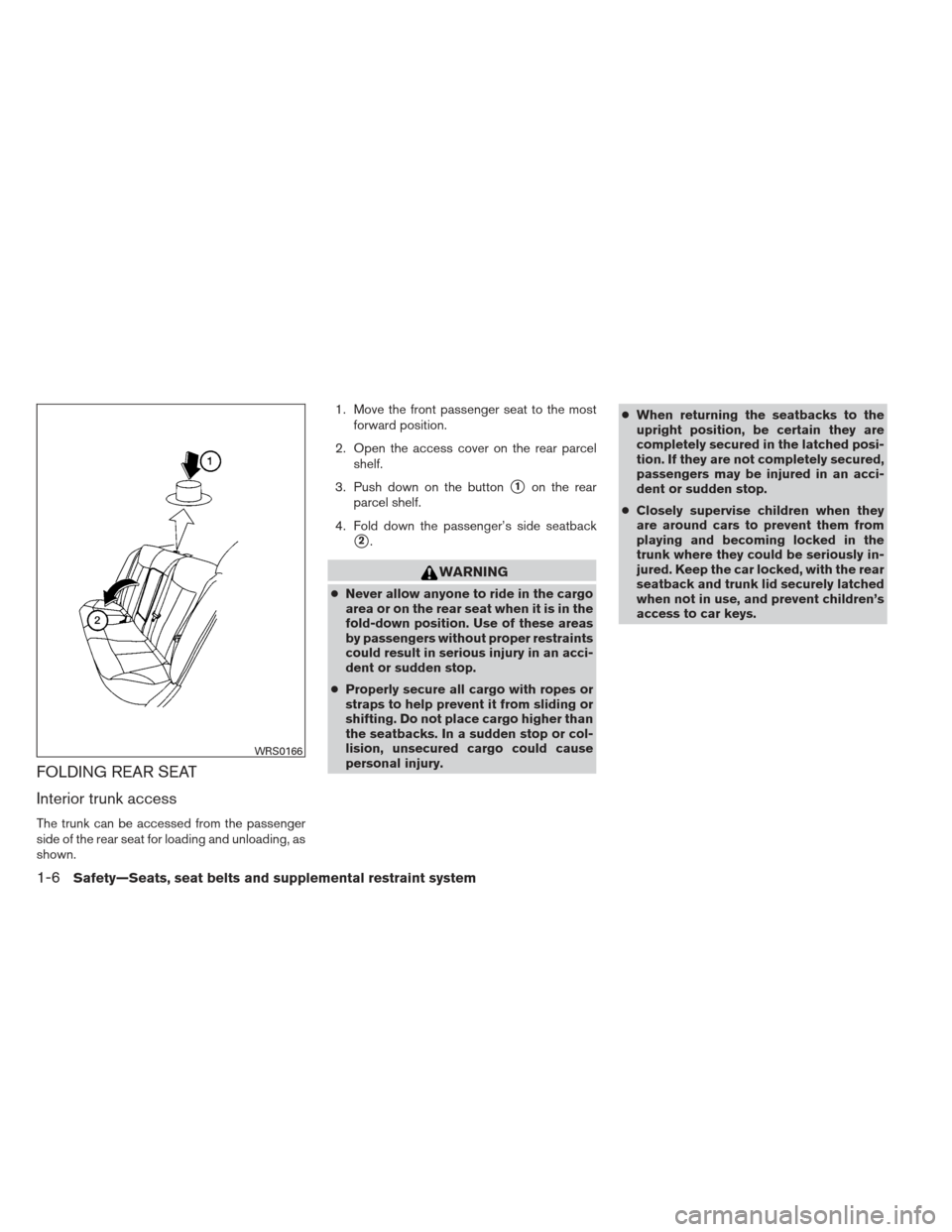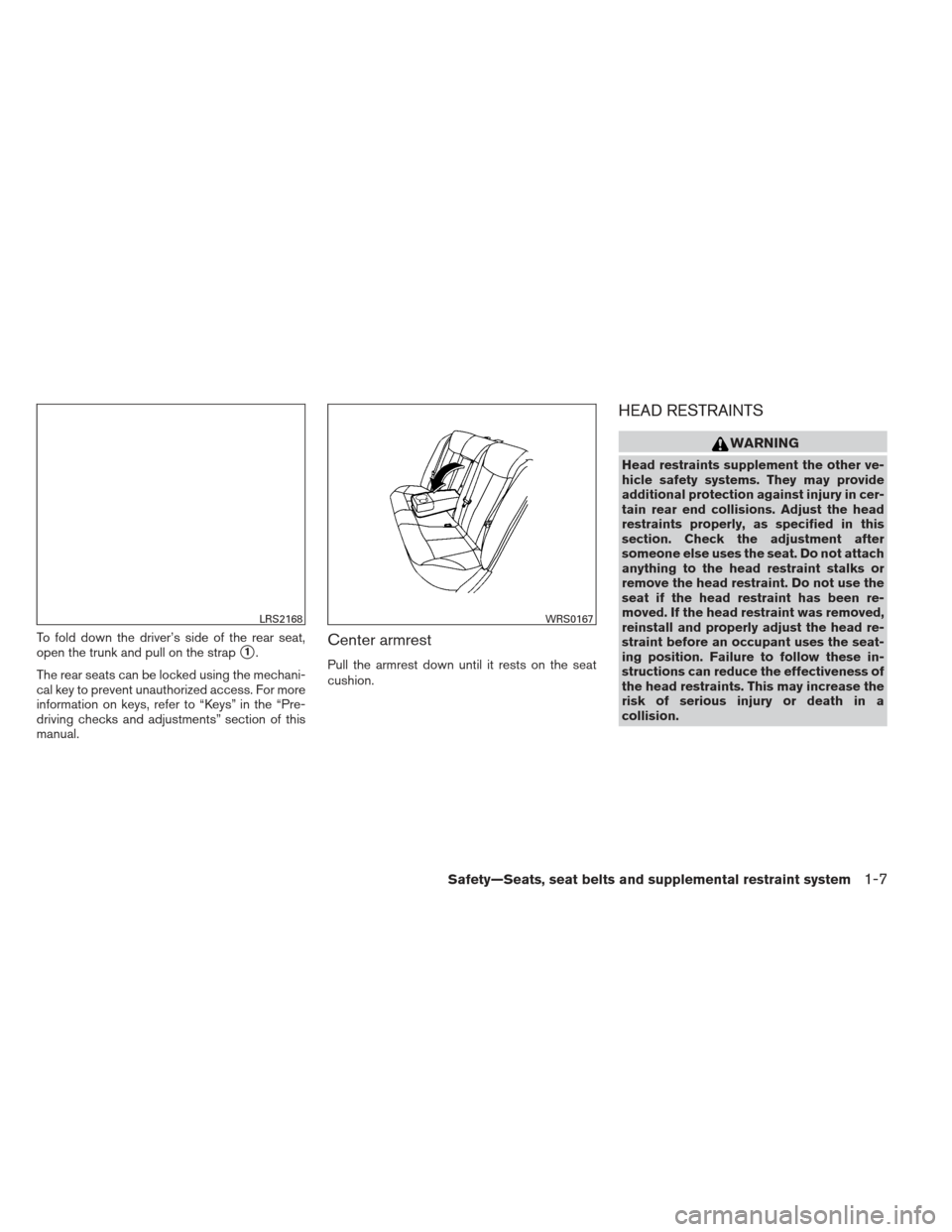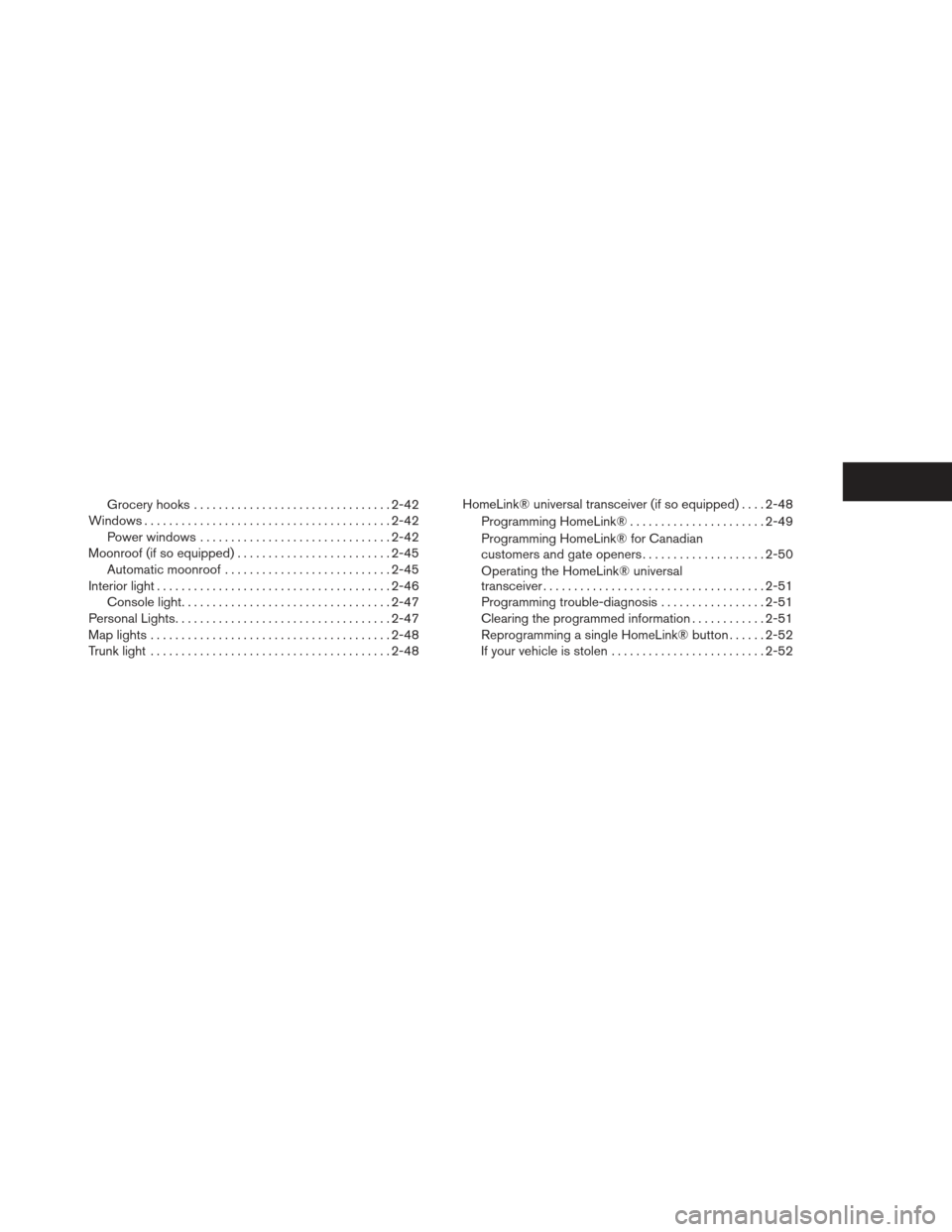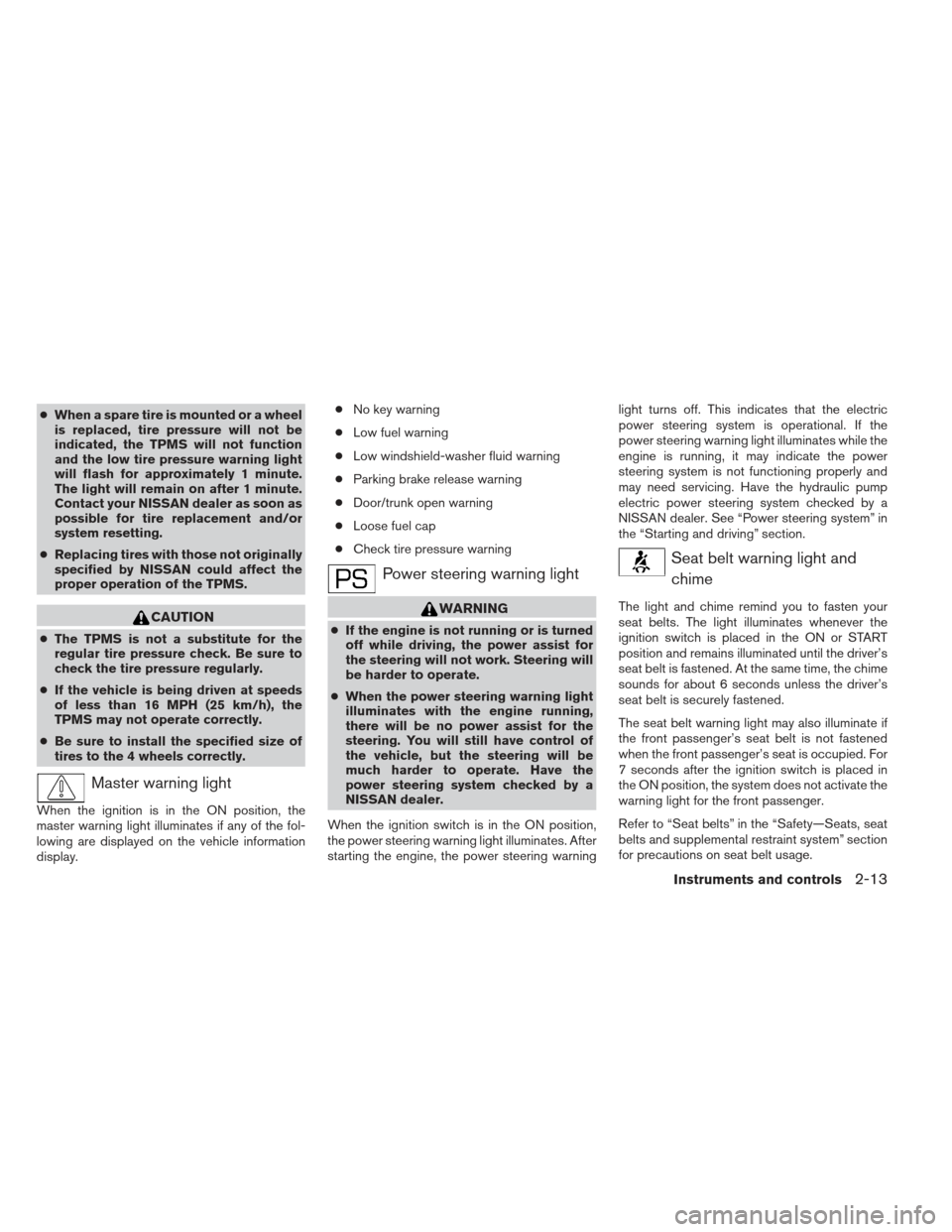Page 11 of 413
1. Rear window defroster switch (P. 2-29)
2. Interior trunk lid release (P. 3-29)
3. Trunk lid (P. 3-27)
4. Opener operation (P. 3-27)
5. Replacing bulbs (P. 8-28)
6. Fuel-filler cap, fuel recommendation(P. 3-30, P. 9-3)
7. Fuel-filler door (P. 3-30)
8. Child safety rear door lock (P. 3-6)
See the page number indicated in paren-
theses for operating details.
LII2039
EXTERIOR REAR
0-4Illustrated table of contents
Page 12 of 413
1. Interior trunk access (P. 1-6)
2. Moonroof (if so equipped) (P. 2-45)
3. Sun visors (P. 3-32)
4. Interior lights, illuminated entry (P. 2-46)
5. HomeLink® universal transceiver(if so equipped) (P. 2-48)
6. Automatic anti-glare rearview mirror
(if so equipped) (P. 3-33)
7. Glove box (P. 2-41)
8. Cup holders (P. 2-40 )
9. Console box (P. 2-41)
10. Front seat (P. 1-2)
11. Rear seat (P. 1-6)
See the page number indicated in paren-
theses for operating details.
LII2040
PASSENGER COMPARTMENT
Illustrated table of contents0-5
Page 14 of 413
22. Vehicle Dynamic Control OFF switch(P. 2-37)
Trunk opener (P. 3-27)
Heated steering wheel switch
(if so equipped) (P. 2-36)
Warning system switch
(if so equipped) (P. 2-36)
* Refer to the Navigation System Owner’s manual
(if so equipped)
See the page number indicated in paren-
theses for operating details.
Illustrated table of contents0-7
Page 23 of 413

FOLDING REAR SEAT
Interior trunk access
The trunk can be accessed from the passenger
side of the rear seat for loading and unloading, as
shown.1. Move the front passenger seat to the most
forward position.
2. Open the access cover on the rear parcel shelf.
3. Push down on the button
�1on the rear
parcel shelf.
4. Fold down the passenger’s side seatback
�2.
WARNING
● Never allow anyone to ride in the cargo
area or on the rear seat when it is in the
fold-down position. Use of these areas
by passengers without proper restraints
could result in serious injury in an acci-
dent or sudden stop.
● Properly secure all cargo with ropes or
straps to help prevent it from sliding or
shifting. Do not place cargo higher than
the seatbacks. In a sudden stop or col-
lision, unsecured cargo could cause
personal injury. ●
When returning the seatbacks to the
upright position, be certain they are
completely secured in the latched posi-
tion. If they are not completely secured,
passengers may be injured in an acci-
dent or sudden stop.
● Closely supervise children when they
are around cars to prevent them from
playing and becoming locked in the
trunk where they could be seriously in-
jured. Keep the car locked, with the rear
seatback and trunk lid securely latched
when not in use, and prevent children’s
access to car keys.
WRS0166
1-6Safety—Seats, seat belts and supplemental restraint system
Page 24 of 413

To fold down the driver’s side of the rear seat,
open the trunk and pull on the strap
�1.
The rear seats can be locked using the mechani-
cal key to prevent unauthorized access. For more
information on keys, refer to “Keys” in the “Pre-
driving checks and adjustments” section of this
manual.Center armrest
Pull the armrest down until it rests on the seat
cushion.
HEAD RESTRAINTS
WARNING
Head restraints supplement the other ve-
hicle safety systems. They may provide
additional protection against injury in cer-
tain rear end collisions. Adjust the head
restraints properly, as specified in this
section. Check the adjustment after
someone else uses the seat. Do not attach
anything to the head restraint stalks or
remove the head restraint. Do not use the
seat if the head restraint has been re-
moved. If the head restraint was removed,
reinstall and properly adjust the head re-
straint before an occupant uses the seat-
ing position. Failure to follow these in-
structions can reduce the effectiveness of
the head restraints. This may increase the
risk of serious injury or death in a
collision.
LRS2168WRS0167
Safety—Seats, seat belts and supplemental restraint system1-7
Page 72 of 413

Grocery hooks................................ 2-42
Windows ........................................ 2-42
Power windows ............................... 2-42
Moonroof (if so equipped) ......................... 2-45
Automatic moonroof ........................... 2-45
Interior light ...................................... 2-46
Console light .................................. 2-47
Personal Lights ................................... 2-47
Map lights ....................................... 2-48
Trunk light ....................................... 2-48HomeLink® universal transceiver (if so equipped)
....2-48
Programming HomeLink® ......................2-49
Programming HomeLink® for Canadian
customers and gate openers ....................2-50
Operating the HomeLink® universal
transceiver .................................... 2-51
Programming trouble-diagnosis .................2-51
Clearing the programmed information ............2-51
Reprogramming a single HomeLink® button ......2-52
If your vehicle is stolen ......................... 2-52
Page 74 of 413
22. Vehicle Dynamic Control OFF switch(P. 2-37)
Trunk opener (P. 3-27)
Heated steering wheel switch
(if so equipped) (P. 2-36)
Warning system switch
(if so equipped) (P. 2-36)
* Refer to the Navigation System Owner’s manual
(if so equipped)
See the page number indicated in paren-
theses for operating details.
1. Tachometer
2. Warning/indicator lights
3. Vehicle Information Display
4. Speedometer
5. Fuel gauge
6. Odometer/Twin trip odometer 7. Engine coolant temperature gauge
LIC2254
METERS AND GAUGES
Instruments and controls2-3
Page 84 of 413

●When a spare tire is mounted or a wheel
is replaced, tire pressure will not be
indicated, the TPMS will not function
and the low tire pressure warning light
will flash for approximately 1 minute.
The light will remain on after 1 minute.
Contact your NISSAN dealer as soon as
possible for tire replacement and/or
system resetting.
● Replacing tires with those not originally
specified by NISSAN could affect the
proper operation of the TPMS.
CAUTION
●The TPMS is not a substitute for the
regular tire pressure check. Be sure to
check the tire pressure regularly.
● If the vehicle is being driven at speeds
of less than 16 MPH (25 km/h), the
TPMS may not operate correctly.
● Be sure to install the specified size of
tires to the 4 wheels correctly.
Master warning light
When the ignition is in the ON position, the
master warning light illuminates if any of the fol-
lowing are displayed on the vehicle information
display. ●
No key warning
● Low fuel warning
● Low windshield-washer fluid warning
● Parking brake release warning
● Door/trunk open warning
● Loose fuel cap
● Check tire pressure warning
Power steering warning light
WARNING
●If the engine is not running or is turned
off while driving, the power assist for
the steering will not work. Steering will
be harder to operate.
● When the power steering warning light
illuminates with the engine running,
there will be no power assist for the
steering. You will still have control of
the vehicle, but the steering will be
much harder to operate. Have the
power steering system checked by a
NISSAN dealer.
When the ignition switch is in the ON position,
the power steering warning light illuminates. After
starting the engine, the power steering warning light turns off. This indicates that the electric
power steering system is operational. If the
power steering warning light illuminates while the
engine is running, it may indicate the power
steering system is not functioning properly and
may need servicing. Have the hydraulic pump
electric power steering system checked by a
NISSAN dealer. See “Power steering system” in
the “Starting and driving” section.
Seat belt warning light and
chime
The light and chime remind you to fasten your
seat belts. The light illuminates whenever the
ignition switch is placed in the ON or START
position and remains illuminated until the driver’s
seat belt is fastened. At the same time, the chime
sounds for about 6 seconds unless the driver’s
seat belt is securely fastened.
The seat belt warning light may also illuminate if
the front passenger’s seat belt is not fastened
when the front passenger’s seat is occupied. For
7 seconds after the ignition switch is placed in
the ON position, the system does not activate the
warning light for the front passenger.
Refer to “Seat belts” in the “Safety—Seats, seat
belts and supplemental restraint system” section
for precautions on seat belt usage.
Instruments and controls2-13